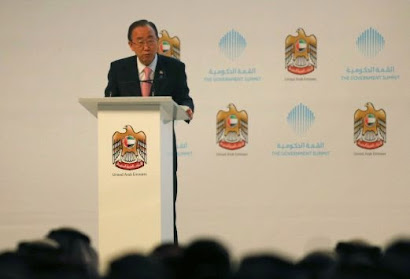Jakarta Globe, Grace Susetyo, December 22, 2012
 |
| Performers during the Saman Summit after UNESCO recognized the Gayonese Saman Dance as an Indonesian Cultural Intangible Heritage. (JG Photo) |
Related
articles
In a
melodious chorus of assalamualaikum, the Arabic greeting meaning “may the peace
of God be upon you,” a group of young boys deliver a flawless, lively and
somewhat spine-chilling welcome dance.
Dressed in
elaborately embroidered black vests and trousers, with red, gold and green
thread, the boys, aged from 6 to 12, skillfully drum their chests in perfect
rhythmic percussion. They are performing Saman, a dance native to the Gayo
highlands of central Aceh and a tradition ingrained deep within their ethnic
roots.
This
performance was one of several to celebrate Unesco’s recent recognition of the
Gayonese Saman dance as an Indonesian Cultural Intangible Heritage in Need of
Urgent Safeguarding.
The
celebratory summit, held last weekend in Taman Fatahillah, Kota Tua, North
Jakarta, was hosted by the Ministry of Education and Culture. It showcased the
various forms of Saman and an array of related Indonesian Islamic dances on a
spectacular high-tech multimedia stage.
“We present
the Saman Summit to give thanks for Unesco’s recognition of Saman as a world
heritage,” said Wiendu Nuryanti, deputy minister of education and culture, in
the opening speech. The recognition was made official in Bali on Nov. 24.
Committee
member Risman Musa said the summit was held in order to introduce the origins
of Saman and to provide an intelligent forum enriched by expressions of
Indonesian tradition, thus fostering a sense of belonging among the people.
The dance
group profiles and the history of the dances were projected through widescreen
video onto the white exterior of Museum Fatahillah, accompanied by high
fidelity audio. The committee hoped that the highly technological presentation
will attract young Indonesians to express contemporary creativity and thus
preserve ancient traditions.
The boys
performing at the celebration were very quick to master the dance because “it
is already in their blood,” said the group’s coach, Syarifuddin.
“Since
birth, these boys grew up watching their fathers and elder brothers dance and
sing in the community. They watched Saman videos in kindergarten and imitated
the singing or the moves during playtime,” Syarifuddin explained.
“Almost
every Saman performer in Gayo is self-taught. All they need to do is to be part
of the community, and join in the dance and music,” he added.
Saman is
commonly performed during special occasions and Islamic holidays, and sometimes
as a friendly competition between villages. Having evolved and been transmitted
almost exclusively by oral tradition, each village in Gayo has its own Saman
style. However, some rules of thumb are to be followed in order for the art
form to qualify as Saman.
Firstly,
Saman is performed by an odd number of performers, usually between 11 and 17,
kneeling in one line facing the audience. A lead singer kneels exactly in the
center, and there are moves that require alternating coordination among the
dancers.
Secondly,
the singing is performed in a combination of Arabic and Gayonese and conveys
Islamic messages.
Thirdly,
Saman is only to be performed by men or boys.
“It is
taboo for females to perform Saman,” said Ben Saifuddin, who has taught
Gayonese and Acehnese dances in Sanggar Pesona, Langsa, for nearly two decades.
“This is because Saman music is exclusively produced through body percussion.
It involves drumming the chest, which would be offensive on women or girls.”
Despite the
taboo that prohibits females from performing Saman, the summit featured women
dancers as well.
Meuseukat
is an Acehnese dance, which, like Saman, is performed by 13 kneeling singing
dancers. To make music, the women carry hand drums called rebana . Instead of
sitting in the center, the lead singer separates herself from the rest of the
dancers, chanting Koranic verses and religious words of wisdom.
The only
unisex dance performed was the Tarek Pukat from Langsa, a town in the southeast
coast of Aceh. Tarek Pukat, which means “pull the net,” is a prayer dance of
the fishermen and their wives.
“As fishermen
prepare to venture out to sea, their wives at home weave nets for them while
praying to Allah to bless their journey with plentiful fish. Fish, as the main
source of protein for coastal peoples, symbolize life, nourishment and
prosperity,” Ben explained.
In addition
to the Gayonese and Acehnese dances, the summit also featured performances of
Islamic dances from other regions, including Pariaman, Cirebon, Jombang and
Lombok.
One of the
most interesting dances was Rodat Syi’iran, performed by the people of
Banyuwangi, East Java.
Rodat is a
dance that takes a V-formation like the flight of heron birds, and “syi’iran”
means poetically lyrical.
Rodat
Syi’iran was originally performed exclusively by men, but in recent years women
have been allowed to participate as was the case at the Saman Summit. The
reasons, as Gandrung leader Haidi puts it, are “purely aesthetical.”
The
Provincial Secretary of Nanggroe Aceh Darussalam, Tengku Setia Budi, hopes
events such as the Saman Summit will help construct a new positive image for
his homeland.
“We hope
that in the future Aceh will be known for Saman, not just for tsunamis and
civilian conflicts,” he said. “We would be delighted if people around the world
would start learning Saman.”
Unesco has
also recognized batik, keris, and wayang as Intangible Cultural Heritages
belonging to Indonesia. Saman is currently the only one originating from
outside Java.
With Saman
now recognized as a World Heritage, various people outside Java are hoping
their customs will make the Unesco list as well, prompting pride and a
significant effort to conserve them.











